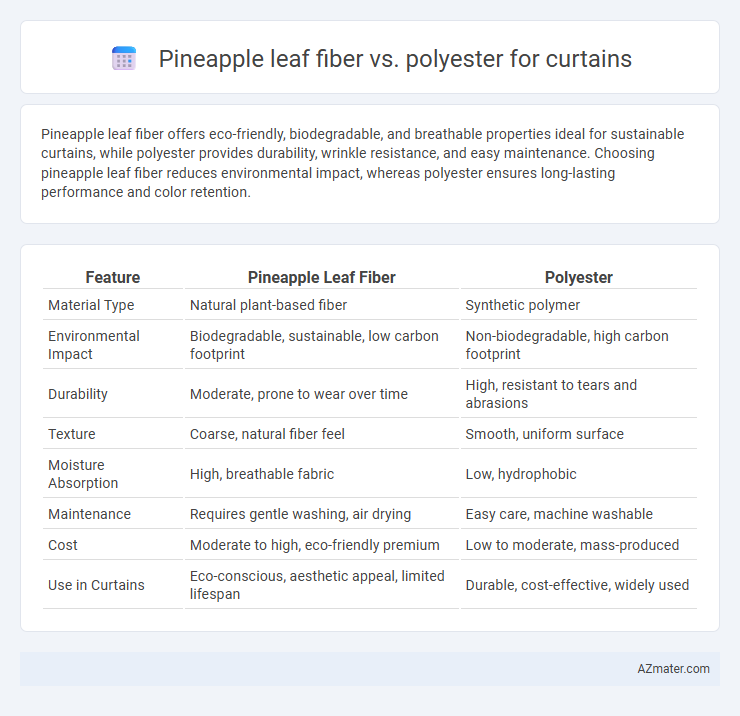Pineapple leaf fiber offers eco-friendly, biodegradable, and breathable properties ideal for sustainable curtains, while polyester provides durability, wrinkle resistance, and easy maintenance. Choosing pineapple leaf fiber reduces environmental impact, whereas polyester ensures long-lasting performance and color retention.
Table of Comparison
| Feature | Pineapple Leaf Fiber | Polyester |
|---|---|---|
| Material Type | Natural plant-based fiber | Synthetic polymer |
| Environmental Impact | Biodegradable, sustainable, low carbon footprint | Non-biodegradable, high carbon footprint |
| Durability | Moderate, prone to wear over time | High, resistant to tears and abrasions |
| Texture | Coarse, natural fiber feel | Smooth, uniform surface |
| Moisture Absorption | High, breathable fabric | Low, hydrophobic |
| Maintenance | Requires gentle washing, air drying | Easy care, machine washable |
| Cost | Moderate to high, eco-friendly premium | Low to moderate, mass-produced |
| Use in Curtains | Eco-conscious, aesthetic appeal, limited lifespan | Durable, cost-effective, widely used |
Introduction to Sustainable Curtain Fabrics
Pineapple leaf fiber is a natural, biodegradable material offering excellent breathability and eco-friendliness for sustainable curtain fabrics, while polyester is a synthetic fiber known for durability and resistance to wrinkles and shrinkage. Pineapple leaf fiber curtains reduce environmental impact by utilizing agricultural waste and minimizing chemical treatments, making them a preferred choice in green interiors. In contrast, polyester curtains, derived from petrochemicals, provide cost-effective maintenance but lack biodegradability and contribute to microplastic pollution.
What is Pineapple Leaf Fiber?
Pineapple leaf fiber is a natural textile fiber extracted from the leaves of the pineapple plant, prized for its eco-friendly and biodegradable properties, making it a sustainable alternative to synthetic fibers like polyester. This fiber boasts high tensile strength, breathability, and a unique texture that enhances curtain durability and aesthetics while reducing environmental impact. Unlike polyester, which is petroleum-based and non-biodegradable, pineapple leaf fiber supports eco-conscious consumers seeking renewable materials for home decor.
Understanding Polyester as a Curtain Material
Polyester is a synthetic fabric widely used for curtains due to its durability, wrinkle resistance, and affordability. Compared to pineapple leaf fiber, polyester offers better color retention and ease of cleaning, making it practical for high-traffic environments. Pineapple leaf fiber, however, provides a more eco-friendly, biodegradable alternative with unique texture but lacks the moisture resistance and longevity inherent to polyester curtains.
Environmental Impact: Pineapple Leaf Fiber vs Polyester
Pineapple leaf fiber is a sustainable textile material derived from agricultural waste, offering biodegradability and a significantly lower carbon footprint compared to polyester, which is petroleum-based and non-biodegradable. The production of pineapple leaf fiber generates minimal greenhouse gas emissions and reduces landfill waste, while polyester contributes to microplastic pollution and relies heavily on fossil fuels. Choosing pineapple leaf fiber curtains supports circular economy practices and reduces long-term environmental damage associated with synthetic fibers.
Durability and Lifespan Comparison
Pineapple leaf fiber curtains offer exceptional durability due to their natural cellulose structure, resisting wear and tear better than many synthetic materials under regular use. Polyester curtains tend to have a longer lifespan, often exceeding 10 years with proper care, thanks to their strong synthetic polymer composition that resists fading and stretching. Comparing durability, pineapple leaf fiber provides eco-friendly strength and breathability, whereas polyester excels in resistance to mildew and UV damage, making both suitable for different durability needs in home textiles.
Texture and Aesthetic Appeal
Pineapple leaf fiber offers a natural, coarse texture with a matte finish, providing an eco-friendly and rustic aesthetic ideal for sustainable interior designs. Polyester curtains feature a smooth, consistent texture with a slight sheen, delivering a sleek and modern look that complements contemporary decor. The tactile variation in pineapple leaf fiber creates a unique, handmade charm, while polyester ensures durability and easy maintenance without compromising visual appeal.
Breathability and Comfort
Pineapple leaf fiber offers superior breathability compared to polyester, allowing air to circulate more freely and reducing heat buildup in curtains. This natural fiber enhances comfort by effectively wicking moisture and maintaining a cooler, fresher environment in indoor spaces. Polyester curtains, while durable and wrinkle-resistant, tend to trap heat and moisture, making them less comfortable in warm or humid conditions.
Cost Analysis and Market Availability
Pineapple leaf fiber curtains typically offer a higher initial cost due to limited production and eco-friendly processing methods compared to polyester, which benefits from mass manufacturing economies. Polyester curtains dominate global markets with widespread availability and lower retail prices, driven by synthetic fiber production scalability. The niche demand for sustainable textiles bolsters pineapple leaf fiber's market growth but remains constrained by seasonal raw material supply and smaller-scale artisan producers.
Maintenance and Care Requirements
Pineapple leaf fiber curtains require gentle hand washing or dry cleaning to maintain their natural texture and prevent weakening of the fibers, with air drying recommended to avoid shrinkage. Polyester curtains are more durable and low-maintenance, allowing for machine washing and quick drying without losing shape or color. Both materials benefit from regular dusting or vacuuming to extend their lifespan and maintain appearance.
Final Verdict: Choosing the Right Curtain Fabric
Pineapple leaf fiber offers a sustainable, biodegradable option with a natural texture and excellent breathability, making it ideal for eco-conscious curtain buyers seeking unique aesthetics. Polyester provides durability, resistance to wrinkles and fading, and affordability, which suits heavy-traffic areas and rooms needing low-maintenance curtains. For an environmentally friendly and natural look, pineapple leaf fiber is the preferred choice, while polyester stands out for longevity and ease of care in practical applications.

Infographic: Pineapple leaf fiber vs Polyester for Curtain
 azmater.com
azmater.com